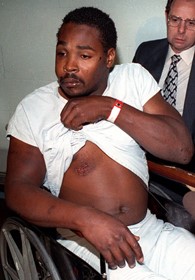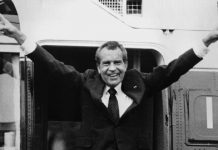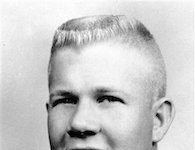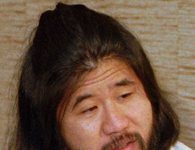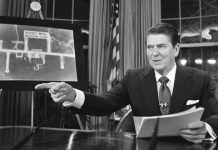On March 3, 1991, a group of white Los Angeles police officers were videotaped severely beating black suspect Rodney King. The officers were later acquitted of excessive force, sparking riots in the city.
The Rodney King Beating
After midnight of March 2, 1991, Rodney King, a 25-year-old black man on parole for armed robbery, drove drunk down a suburban Los Angeles freeway and didn’t pull over when police attempted to pull him over for speeding. After a high-speed pursuit, during which King drove as fast as 117 mph, King acted strangely and resisted arrest.
A group of officers tried to forcibly subdue King and used a Taser several times. Two officers, Laurence Powell and Timothy Wind, began beating King with their nightsticks as a third, Theodore Briseno, kicked King in the head.
In a nearby apartment, George Holliday heard the noise and decided to film the incident from his terrace. The video aired on television news programs across the country, stoking charges of police violence and racial abuse. It “revived charges that the police department has failed to confront an alleged pattern of police brutality and official abuse of minorities among its officers,” wrote The New York Times.
King spent two days in a hospital to treat his injuries, which included a fractured facial bone and numerous bruises. After being released without charges, he spoke to the media while seated in a wheelchair. “I was scared for my life, so I lay down real calmly and took it like a man,” he said.
Sources in this Story
- The New York Times: Tape of Beating by Police Revives Charges of Racism
- University of Missouri-Kansas City School of Law: Los Angeles Police Officers’ (Rodney King Beating) Trials
- Time: L.A. Lawless
- Time: The Fire This Time
The Trial of the LAPD Officers
Officers Powell, Wind and Briseno were indicted along with Officer Stacey Koon, the supervising officer at the scene, for use of excessive force. The trial’s venue was changed from Los Angeles County to the conservative and primarily white Simi County, and the jury was predominately white.
The trial began in March 1992. In his opening statement, prosecutor Terry White showed the full, unedited video of King’s arrest, which included footage of King resisting arrest that was cut out of most news reports. According to Lou Cannon, author of “Official Negligence: How Rodney King and the Riots Changed Los Angeles and the LAPD,” this helped turned jury members against the prosecution.
Officer Powell emerged as the most controversial figure of the trial. In messages on his in-car computer on the night of the King beating, he boasted about beating King and referred to a black couple as “Gorillas in the Mist.” He also failed a baton training exercise before going out on duty that night. Two fellow officers, including Brisero, testified that he used excessive force.
Though he had not taken part in the beating, Officer Koon faced questions about whether his men had behaved properly; Koon defended their actions. The prosecution presented little evidence against either Wind or Brisero, who was critical of his fellow officers.
On April 29, 1992, the jury found all four men not guilty. The decision sparked anger in Los Angeles’ black community and incited a riot.
The four officers would go on to face federal charges for violating King’s civil rights. In April 1993, Powell and Koon were found guilty and sentenced to 30 months in prison.
Related Events
The L.A. Riots
The riots started in South Central Los Angeles after the not guilty verdicts were read. A white truck driver, Reginald Denny, and a Guatemalan immigrant, Fidele Lopez, were beaten by a group of black men at a stoplight in South Central. Both attacks were filmed by a news helicopter and became symbols of the violence.
The rioters, mostly young black men set fires, looted stores and attacked non-whites. The police were reluctant to enter the areas of rioting except for life-threatening situations. King went on television on the third day of rioting to plead for it to end; “Can we all get along?” he asked.
After five days, the riots died down; 54 people, mostly Latinos and Asians, were killed and there was more than $1 billion in damages.


